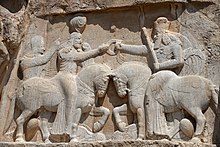Ahura Mazda and Ardashir I

Ahura Mazda and Ardashir I is a
The inscription shows
Inscription
There's an inscription on Ardashir's horse in three languages: Middle Persian, Parthian and Greek. The inscription reads as "This is the figure of Mazdaworshiper, the lord Ardashir, Shahanshah of Iran, whose lineage is from Gods, the son of the lord Papak, the king". There's also another inscription on Ahuramazda's horse in aforementioned languages. The Greek version of this inscription reads as "This is the figure of the God Zeus", whereas the Middle Persian version reads as "This is the figure of the God Ahuramazda".

This inscription seems to be the oldest inscription from the Sasanian period. Above the Ahura Mazda's figure, there's another three small inscriptions in the aforementioned languages with same content, which reads as "This is Ahura Mazda's (bagh) figure".[1]
References
- ISBN 964-5983-14-2

